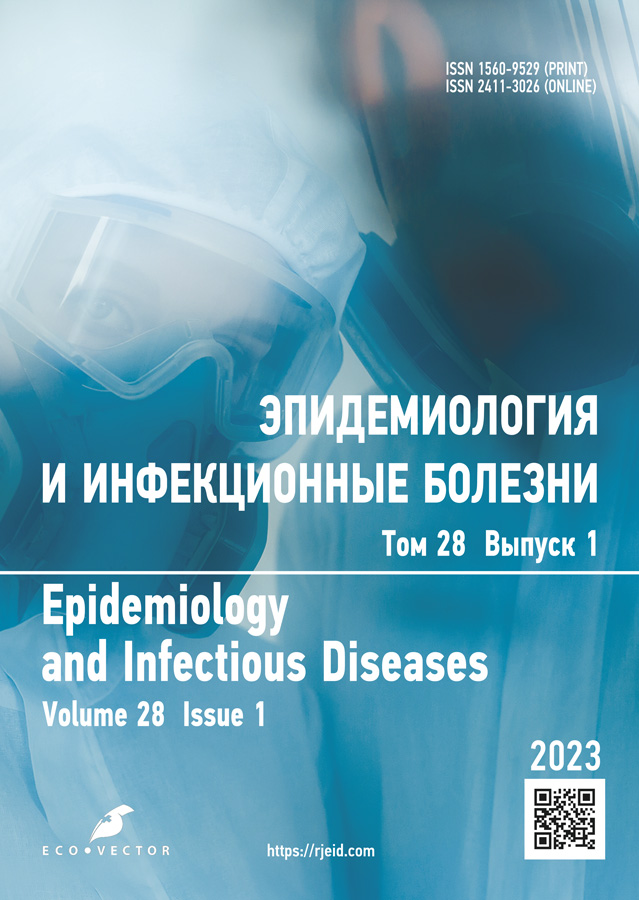Antimicrobial properties of oxygen-active disinfectants
- Authors: Gerasimov V.N.1, Kharseeva G.G.2, Gaitrafimova A.R.1, Bystrova E.V.1, Fedorova L.S.3
-
Affiliations:
- State Research Center for Applied Microbiology and Biotechnology
- Rostov State Medical University
- Research Institute for Systems Biology and Medicine
- Issue: Vol 28, No 1 (2023)
- Pages: 44-52
- Section: Reviews
- Submitted: 15.02.2023
- Accepted: 03.03.2023
- Published: 22.03.2023
- URL: https://rjeid.com/1560-9529/article/view/237986
- DOI: https://doi.org/10.17816/EID237986
- ID: 237986
Cite item
Abstract
Oxygen-active disinfectants are widely used for the nonspecific prevention of infectious diseases: hydrogen peroxide, chlorine dioxide, potassium fluoride peroxyhydrate, perborates, persulfates, perphosphates, and percarbonates. These compounds have a broad spectrum of antimicrobial activity against bacteria (including Mycobacterium tuberculosis), viruses, fungi, and spores of bacilli.
The primary exposure “targets” exposure for oxygen-containing disinfectants are proteins and lipids in the cytoplasmic membranes of bacterial cells and the spore membranes of bacterial spores. When a bacterial cell is exposed to hydrogen peroxide at the stage of contact with the cytoplasmic membrane, hydrogen peroxide decomposes into highly reactive hydroxyl radicals, which have a destructive effect on the membranes. Hydroxyl radicals are powerful oxidizing agents, have a short existence and interact with lipids, proteins, and nucleic acids. Lipid oxidation, mainly unsaturated fatty acids, leads to increased membrane permeability. During the membrane protein oxidation consisting of amino acids with disulfide bonds, the latter are converted into –SH-radicals, forming cross-links at amino groups and resulting in protein-lipid complexes. The proteins are oxidized and denatured, leading to cell death. Hydroxyl radicals and other intermediate decomposition products of hydrogen peroxide, such as hydronium cation (Н3О+) and perhydroxylanion (НО2-), have damaging effects.
This article analyzes scientific papers on the mechanism of action of oxygen-active disinfectants on vegetative cells and bacterial spores.
Full Text
About the authors
Vladimir N. Gerasimov
State Research Center for Applied Microbiology and Biotechnology
Email: ilcvngerasimov@obolensk.org
ORCID iD: 0000-0002-0473-7785
SPIN-code: 8666-4481
Dr. Sci. (Biol.)
Russian Federation, ObolenskGalina G. Kharseeva
Rostov State Medical University
Email: galinagh@bk.ru
ORCID iD: 0000-0002-6226-2183
SPIN-code: 7740-4921
MD, Dr. Sci. (Med.), Professor
Russian Federation, 29 Nakhichevan alleyway, 344022 Rostov-on-DonAigul R. Gaitrafimova
State Research Center for Applied Microbiology and Biotechnology
Email: gula.70@inbox.ru
ORCID iD: 0000-0002-9113-7322
SPIN-code: 2791-3786
Russian Federation, Obolensk
Elena V. Bystrova
State Research Center for Applied Microbiology and Biotechnology
Email: elena542007@yandex.ru
ORCID iD: 0000-0002-1941-0793
SPIN-code: 9080-2775
Russian Federation, Obolensk
Ludmila S. Fedorova
Research Institute for Systems Biology and Medicine
Author for correspondence.
Email: fedorova-is@yandex.ru
ORCID iD: 0000-0002-3345-2631
SPIN-code: 3042-0126
MD, Dr. Sci. (Med.), Professor
Russian Federation, MoscowReferences
- Shandala MG. Actual tasks of scientific support of disinfection practice. Disinfection affairs. 2008;(2):23–26. (In Russ).
- Ivanova EB. The relevance of disinfection measures in ensuring biological safety. Dezinfektsiya. Antiseptika. 2010;(1):20–25. (In Russ).
- Shestopalov NV. Disinfectology and disinfection business is the basis of non-specific prevention of infectious diseases. Journal of microbiology, epidemiology and immunobiology. 2013;(1):105–108. (In Russ).
- Fedorova LS. Theory and practice of improving disinfectants. Moscow: Medicine; 2006. 214 p. (In Russ).
- Vetkina IF, Komarinskaya LV, Ilyin YuI, Solovieva MV. A modern approach to the choice of disinfectants in the system of prevention of nosocomial infections (HAI). FARM indeks Praktik [online resource]. 2005;(7):13–20. (In Russ).
- Pkhakadze TYa. Antiseptic and disinfectants in the prevention of nosocomial infections. Clinical microbiology and antimicrobial chemotherapy. 2002;4(1):42–48. (In Russ).
- Gerasimov VN, Dyatlov IA, Gaytrafimova AR, et al. Experimental selection of peroxide composite disinfectants with a sporicidal effect. Disinfection affairs. 2014;(2):9–14. (In Russ).
- Gavrilova IA, Zhavnerko GK, Titov LP. Atomic force microscopy of morphostructural changes in Pseudomonas aeruginosa exposed to a biocide based on alkyldimethylbenzylammonium chloride and polyhexamethyleneguanidine. Doklady Nacionalʹnoj akademii nauk Belarusi. 2013;57(5):81–87. (In Russ).
- Mc Donnell G, Russell AD. Antiseptics and disinfectants: Activity, astion and resistance. Clin Microbiol Rev. 1999;12(1):147–179. doi: 10.1128/CMR.12.1.147
- Lengeler J, Drews G, Schlegel G. Modern microbiology. Moscow: Mir; 2005. 325 р. (In Russ).
- Vorobyev AA, Bykov AS, Boychenko MN, et al. Medical microbiology, virology and immunology. Ed. by A.A. Vorobyov. 3rd revised and updated. Moscow: Meditsinskoe informatsionnoe agentstvo; 2022. 704 p. (In Russ).
- Korchak GI, Klimenko IV, Surmasheva EV, et al. Mechanisms of resistance of bacteria and viruses to disinfectants and antiseptics. Enviroxment & Health. 2019;(4):70–79. (In Russ). doi: 10.32402/dovkil2019.04.070
- Legotsky SA. Preparation, study of properties, stabilization of recombinant endolysin of bacteriophage S-394 and development of a method for effective lysis of gram-negative bacteria [dissertation abstract]. Moscow; 2016. 29 р. (In Russ).
- Fedorova LS, Tsvirova IM, Levchuk NN, Belova AS. Oxygen-active disinfectants (Literature review). Disinfection affairs. 2013;(2):28–33. (In Russ).
- Samoilenko II, Vasilyeva EI, Pavlova IB, Tumanyan MA. Mechanisms of the bactericidal action of hydrogen peroxide. Journal of microbiology, epidemiology and immunobiology. 1983;(12):30–33. (In Russ).
- Shestopalov NV, Fedorova LS, Skopin AYu. Antimicrobial activity and minimum effective concentrations of chemical compounds found in disinfectants. Hygiene and Sanitation. 2019;98(10):1031–1036. (In Russ). doi: 10.47470/0016-9900-2019-98-10-1031-1036
- Friedovich M. Oxygen radicals, hydrogen peroxide and oxygen toxicity Free radicals in biology. Vol. 1. Ed. by A. Pryor. Trans. from English. Moscow: Mir; 1979. Р. 272–378. (In Russ).
- Goncharuk EI. Communal hygiene. Kiev: Vysshaya shkola; 2000. 652 р. (In Russ).
- Ozerov MYu, Karkishchenko VN, Popov DV, et al. Means for disinfection of objects contaminated with B. anthracis spores. Biomeditsina. 2009;(1):28–32. (In Russ).
- Linley E, Denyer SP, McDonnell G, et al. Use of hydrogen peroxide as a biocide: New consideration of its mechanisms of biocidal action. J Antimicrob Chemother. 2012;67(7):1589–1596. doi: 10.1093/jac/dks129
- Vladimirov YuA. Free radicals in biological systems. Sorov Educational J. 2000;6(12):13–19. (In Russ).
- Bukharin OV, Sgibnev AV, Cherkasov SV. Comparative characteristics of the antimicrobial effects of hydroxy radicals and hydrogen peroxide. Disinfection affairs. 2013;(3):38–42. (In Russ).
- Leggett MJ, Schwars S, Burke PA, et al. Mechanism of sporicidal activity for the synergistic combination of peracetic acid and hydrogen peroxide. Appl Environ Microbiol. 2015;82(4):1035–1039. doi: 10.1128/AEM.03010-15
Supplementary files










